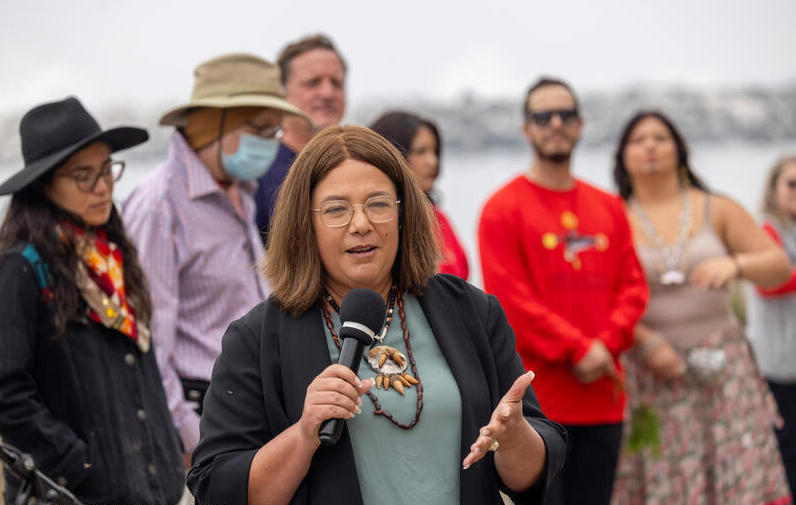
- Details
- By Chez Oxendine
- Energy | Environment
The Northern Chumash Tribe has reached an agreement with offshore wind leaseholders that could expedite the long-awaited approval of a marine sanctuary to protect endangered species and sacred sites.
After a decade of advocating for the Chumash Heritage National Marine Sanctuary off the California coast, the tribe has agreed to a temporary modification of its proposed plan. The modification would shorten the sanctuary’s proposed northern boundary, helping the leaseholders avoid regulatory issues during the construction of three wind-farm projects over the next year.
In exchange, the Morro Bay Wind Energy Area leaseholders — Equinor, Invenergy, and Ocean Winds — have pledged to support the marine sanctuary’s nomination and establishment process.
It’s not a perfect solution, but it moves the sanctuary one step closer to reality, according to Northern Chumash Tribal Council Chairwoman Violet Sage Walker, who once vowed, “There’s no way that windmills there will ever swing their blades out there.”
Sage makes it clear that the recent agreement isn’t an endorsement of offshore wind, which many tribes along the Oregon and California coasts have questioned. Rather, it’s an acknowledgement that the marine sanctuary and wind projects are separate issues, she said.
“I feel for people that are concerned about offshore wind … but this is not what that is,” Walker told Tribal Business News. “I did not make any concessions. I just asked the off-shore wind people to support the marine sanctuary and adjusted the border to allow them to build.”
 Violet Sage Walker, chairwoman of the Northern Chumash tribal council, speaks in Sept. 2023 at a rally at the base of Morro Rock to support the boundaries of the Chumash Sanctuary. (Photo: David McNew, Greenpeace)
Violet Sage Walker, chairwoman of the Northern Chumash tribal council, speaks in Sept. 2023 at a rally at the base of Morro Rock to support the boundaries of the Chumash Sanctuary. (Photo: David McNew, Greenpeace)
The sanctuary’s establishment has been a decade in the making and Walker has been one of its key proponents. It’s the first such nomination for a marine sanctuary made directly by a Native American tribe.
The Northern Chumash Tribal Council nominated the Chumash Heritage National Marine Sanctuary in 2015. Marine sanctuaries are established by the National Oceanic and Atmospheric Administration (NOAA) Office of National Marine Sanctuaries, or ONMS. Backed by the National Marine Sanctuaries Act, these sanctuary areas are subject to tight restrictions on development.
In its current iteration, the Chumash sanctuary’s proposed boundary sits south of Diablo Canyon and north of Port San Luis and Avila Beach. The sanctuary would protect endangered species, like southern sea otters, as well as cultural resources and sacred sites, Walker said.
Right now, the sanctuary is on the cusp of approval during the next few months. With studies completed and public comments closed, only final approvals from the California Coastal Commission and the Biden administration remain. But a potential clash loomed: because the Morro Bay wind area overlapped the sanctuary’s proposed boundaries, marine regulations would have interfered with construction in the wind energy area.
Without an agreement, the sanctuary risked losing the support of the Biden administration, which awarded the offshore wind leases in Dec. 2022. That reality meant it was time to bring the leaseholders to the table to forge a compromise, Walker said.
“[Conflict with the leaseholders] could delay the sanctuary until we lose the window of opportunity, depending on how the election goes. I don't think it's fair to be held in limbo because of a separate project,” Walker said. “One should go forward without being conditional upon the other. We don't want to see our work sidelined until we can come to a perfect agreement.”
Walker spoke with the leaseholders and came to an agreement: the northern border would be adjusted. That would leave the area between the Chumash sanctuary and other marine sanctuaries open, where regulations wouldn’t interfere with construction.
Once construction is complete in 2025, the leaseholders have pledged to support restoring the Chumash Sanctuary’s original proposed boundaries. In total, the completed sanctuary would protect nearly 19,000 square miles of ocean, Walker said. That made it worth coming to an understanding that the two projects shouldn’t interfere with one another.
Golden State Wind CEO Tyler Studds called the agreement the latest step in ongoing discussions with tribes in the area. The three leaseholders have been collaboratively speaking with 14 tribes along the coast for the past 8 months, Studds said.
“We are…focused on efforts to engage with all stakeholders,” Studds wrote in an email to Tribal Business News. “We are investing in a long-term relationship with local communities guided by our commitment to building long-lasting partnerships with coastal communities and ocean users.”
Martin Goff, head of operations for Equinor’s Atlas Wind subsidiary, said the agreement “clearly demonstrates that Tribal communities and industry can come together with dual goals to support climate action and conservation, benefiting California’s just energy transition.”
For Walker, it boiled down to the culmination of her “life’s work,” she said.
“I could have done anything, but this is what I wanted to do. It meant a lot to my late father, my grandparents and elders,” Walker said. “This will be something the Native community can look at and say, ‘it wasn’t perfect, but it was the first time we’ve ever gotten something like this done.’”
